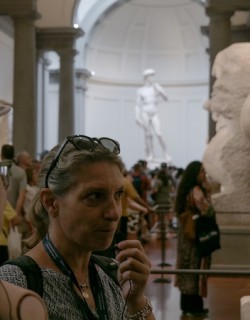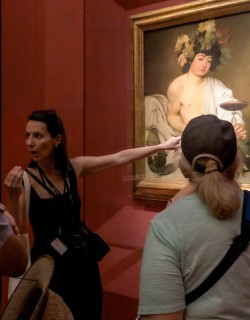Once used as administrative offices or uffizi - hence the name - the Uffizi Gallery now houses one of the most impressive art collections in the world. It was originally used to display masterpieces owned by the Medici family, and in 1765 it was opened to the public as one of the first modern museums.
Going on an Uffizi Gallery tour with an expert guide (an art historian) will help you to make the most of your trip. You’ll get to skip the lengthy lines outside the gallery, spending more time exploring the Uffizi’s vast collection of Medieval, Renaissance and Baroque art. Many of the greatest paintings of all time are displayed in the Uffizi, and on your tour you’ll see works by artists such as Leonardo da Vinci, Raphael, Botticelli, Michelangelo, Titian and Caravaggio, as well as some underrated treasures by lesser-known artists.
Even the most enthusiastic art lover is unlikely to have the stamina for the entire collection of the Uffizi, but some paintings are unmissable. Here are a few of the highlights:
1. The Birth of Venus by Botticelli
The works of the Florentine painter can be found in churches and galleries throughout the city, but his most famous works, Primavera and The Birth of Venus are both displayed in the Uffizi. The latter may have been commissioned by the Medici family in the 1480s, and it remains one of the most celebrated paintings of the Renaissance. The figure of Venus rising out of the sea represents an ideal of female beauty, and has been interpreted by some as a representation of Simonetta Vespucci, a young noblewoman who was considered the greatest beauty of her age. While one historian has dismissed the identification of Simonetta Vespucci in The Birth of Venus as “romantic nonsense”, Botticelli, much like all the other men in Florence, seems to have had a soft spot for Simonetta. At his request, he was buried next to her in the church of Ognissanti.
The mysterious nature of Botticelli’s Venus is part of the painting’s charm. It is also characterised by a lack of naturalism - note Venus’s unrealistic pose and the absence of shadows - which distinguishes Botticelli from his contemporaries. The combination of a pagan theme, female beauty and a dreamlike atmosphere has made The Birth of Venus one of the most popular Renaissance paintings, and an undisputed highlight of the Uffizi.
2. Annunciation by Leonardo Da Vinci
In contrast to Botticelli’s fantasy scene, Da Vinci takes a more realistic approach in his version of the Annunciation. He was so concerned about realism that he even made chalk models of the figures in his painting and clothed them, to observe how the clothing draped over the figure.
The Annunciation - the scene where the angel Gabriel tells the Virgin Mary that she’s going to give birth to the Son of God - was a popular subject for medieval and Renaissance paintings. In most earlier paintings the meeting takes place indoors, but Da Vinci’s Gabriel finds Mary outside, in a beautiful garden. In the background is a mysterious landscape lined by cypresses, with mountains and a lakeside town in the distance, filling the space between Gabriel and Mary. The painting would be an immense achievement for any artist, but it’s even more remarkable considering that Da Vinci was only in his early twenties when he completed this masterpiece.
3. Perseus Freeing Andromeda by Piero di Cosimo
Piero di Cosimo was famous for his eccentricities - a phobia of thunderstorms and an obsession with hardboiled eggs - but on your Uffizi tour you’ll also discover why he achieved such great fame as a painter. He was strongly influenced by early Netherlandish painting, and often painted mythological or allegorical subjects in a highly distinctive, personal style. In this painting Perseus attacks a bizarre-looking sea monster to rescue Andromeda, the daughter of an Ethiopian king. The crowds gathered on the shore are indifferent to the dramatic scenes behind them, as they’re too busy dancing and playing strange musical instruments, which would be impossible to play in reality. It’s an imaginative work with a beautiful composition, and Vasari rated it highly:
Piero never made a more lovely or more highly finished picture than this one, seeing that it is not possible to find a more bizarre or more fantastic sea-monster than that which Piero imagined and painted, or a fiercer attitude than that of Perseus, who is raising his sword in the air to smite the beast. In it, trembling between fear and hope, Andromeda is seen bound, most beautiful in countenance ; and in the foreground are many people in various strange costumes, playing instruments and singing; among whom are some heads, smiling and rejoicing at seeing the deliverance of Andromeda, that are divine. The landscape is very beautiful, and the coloring sweet and full of grace. In short, with regard to the harmony and gradation of the colors, he executed this work with the greatest possible diligence.
4. Portrait of Eleonora of Toledo by Bronzino
Eleonora was the Duchess of Florence, and the wife of Cosimo I de’ Medici. This portrait by Bronzino depicts a stern, elegantly dressed Eleonora with one of her young sons (probably Giovanni). Some consider it to be a strangely cold and unemotional painting, especially when compared to other, more loving portrayals of mothers with their children, but the portrait has also been acclaimed as one of the greatest examples of Mannerist portraiture, rejecting the naturalism of Renaissance art in favour of a heightened style or elegance.
Bronzino’s intention is not to depict maternal love or family intimacy, but rather to showcase the wealth and power of the Medici dynasty. Eleonora’s magnificent brocaded silk dress is the focal point of the painting. Looking at the face of mother and son gives us no clue about the true nature of their personalities, or their relationship with one another. Their alabaster skin makes them seem almost preternaturally perfect, like the pearls around Eleonora’s neck.
Tragically, both mother and son died of malaria within a month of each other, along with Giovanni’s younger brother Garzia. Eleonora was 40, while Giovanni and Garzia were both in their teens.
5. Venus of Urbino by Titian
There are many masterpieces by Titian in the Uffizi, but this painting of Venus is one of his greatest and most famous works. Like Botticelli’s Venus, Titian’s Venus is nude, blonde and beautiful, but that’s where the similarities end. The Birth of Venus is a much more ethereal scene, clearly alluding to mythology, whereas Venus of Urbino puts the goddess in a domestic and more overtly erotic setting. The model for Venus was probably Angela del Moro, a well-known Venetian courtesan, and the painting would have decorated a cassone (a chest given as a wedding present), commissioned by the Duke of Urbino, possibly as a gift for his young bride-to-be. A dog - traditionally a symbol of fidelity - sleeps at the end of the bed.
Titian’s most sensual and seductive work, Venus of Urbino is striking for its rich colours, subtle symbolism, and unapologetic eroticism.
~by Alexandra Turney~


